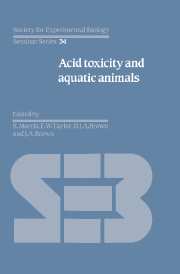Book contents
- Frontmatter
- Contents
- Contributors
- Units, Symbols and Formulae
- Preface
- Introduction: The causes and consequences of surface water acidification
- Invertebrate communities in acid streams
- Fish survival in acid waters
- Field studies on fisheries in acid waters in the UK
- Episodic changes in water quality and their effects on fish
- Acid–base regulation in fishes: 1. Mechanisms
- Acid–base regulation in fishes: 2. Biological responses and limitations
- Intracellular pH regulation and the effects of external acidification
- The physiological problems of fish in acid waters
- Laboratory studies on invertebrate survival and physiology in acid waters
- The physiological problems of crayfish in acid waters
- The effects of hydrogen and aluminium ions on fish gills
- The combined effects of pH and trace metals on fish ionoregulation
- Endocrine responses to acid stress in fish
- Commentary and conclusions
- Index
Field studies on fisheries in acid waters in the UK
Published online by Cambridge University Press: 05 February 2012
- Frontmatter
- Contents
- Contributors
- Units, Symbols and Formulae
- Preface
- Introduction: The causes and consequences of surface water acidification
- Invertebrate communities in acid streams
- Fish survival in acid waters
- Field studies on fisheries in acid waters in the UK
- Episodic changes in water quality and their effects on fish
- Acid–base regulation in fishes: 1. Mechanisms
- Acid–base regulation in fishes: 2. Biological responses and limitations
- Intracellular pH regulation and the effects of external acidification
- The physiological problems of fish in acid waters
- Laboratory studies on invertebrate survival and physiology in acid waters
- The physiological problems of crayfish in acid waters
- The effects of hydrogen and aluminium ions on fish gills
- The combined effects of pH and trace metals on fish ionoregulation
- Endocrine responses to acid stress in fish
- Commentary and conclusions
- Index
Summary
Introduction
The term ‘acid water’ is variously defined in the literature, but it is usual to adopt an upper limit of pH 5.6, equivalent to the pH of pure water in equilibrium with atmospheric carbon dioxide. The UK Acid Waters Review Group (1986) thus defines three categories of water with respect to acidity:
(i) ‘permanently acid’: pH usually < 5.6, alkalinity zero or close to zero;
(ii) ‘occasionally acid’: pH occasionally < 5.6, low alkalinity;
(iii) ‘never acid’: pH never < 5.6, well buffered.
Although no survey of acid water distribution in the UK has ever been undertaken, the likely distribution can be inferred from the combination of solid and drift geology and soil type. Maps of these characteristics are given by the UK Acid Waters Review Group (1986), and a composite map is shown in Figure 1. This indicates a probable distribution of acid waters in the UK, predominantly to the west and north.
As far as fish are concerned, the definition of an acid water is arbitrary. Fish have been shown to exist in a wide range of pH levels, from 3.5 to 11; also, their response to acid conditions is determined by a complex of other factors such as related increases in toxic metal levels or indirect effects upon food organisms (Alabaster & Lloyd, 1980; Howells, 1983). The purpose of field studies is to establish the net effect of these combining or competing factors on fishery status.
- Type
- Chapter
- Information
- Acid Toxicity and Aquatic Animals , pp. 45 - 66Publisher: Cambridge University PressPrint publication year: 1989
- 6
- Cited by



